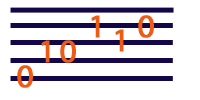JSyn
: Documentation
| Examples
| Download
| Beta
| Support
| Apps
| Press
| Events
WARNING - This tutorial describes the old original JSyn API. Please refer to the current docs for more up-to-date information.
JSyn Tutorial
| Top | Previous | Next | #26/51
Using One Oscillator to Control Another
In a previous example, we learned how to set the frequency of an oscillator
by calling:
sineOsc2.frequency.set( 550.0 );
Suppose that now you want the frequency of the oscillator to waver up and
down smoothly like a siren. You could calculate the frequency for the siren
at each moment and then set the frequency of the oscillator.
double freq = CalculateSirenFreq(); // generate rising and falling value
sineOsc2.frequency.set( freq );
But this could require thousands of calls per second to make it sound smooth.
Fortunately there is a better way. You can use the output of one oscillator
to control another oscillator. You can do this by connecting the output
of one oscillator to the frequency port of a second oscillator.
sineOsc1.output.connect( sineOsc2.frequency );
Now the output of the first oscillator normally ranges from -1.0 to +1.0.
If the frequency of the second oscillator is between -1.0 and +1.0 then
we will neve hear it because that is below the range we can hear. So let's
change the amplitude of the first oscillator so that it covers a range
we can hear, -200.0 to +200.0. Also let's change the frequency of the modulating
oscillator so that it is a slow one cycle per second.
sineOsc1.amplitude.set( 200.0 );
sineOsc1.frequency.set( 1.0 );
The next step might be to make the frequency to waver slightly about a
central frequency that is in a more useful range. We can do this by using
an AddUnit to add the output of an oscillator to a constant value that
we can set. We can also reduce the amplitude of the first oscillator to
be within a smaller range.
AddUnit freqAdder = new AddUnit();
sineOsc1.output.connect( freqAdder.inputA ); // pass through adder
freqAdder.output.connect( sineOsc2.frequency ); // control second oscillator freq
freqAdder.inputB.set( 500.0 ); // add constant that will center us at 500 Hz
sineOsc1.amplitude.set( 100.0 ); // reduce offset to +/- 100 Hz
Thus the frequency of sineOsc2 will be sineOsc1.output plus inputB.
| Top | Previous | Next | #26/51
